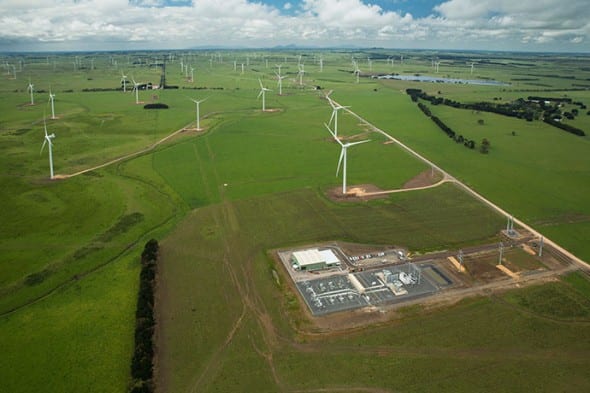Last week’s sale by AGL Energy of a 50 per cent stake in the country’s biggest wind farm, the Macarthur project in Victoria, got a lot of headlines that focused on one big number – the $532 million sale price.
But a more important number went un-noticed – the $79/MWh price that AGL will pay for the output from Macarthur as part of the off-take agreement it has with the new investor owners.
The sale price confirms that the cost of wind energy in Australia has fallen below $80/MWh. This much was elicited from the recent ACT wind auction, which set prices at between $81.50/MWh and $92/MWh, but considering that those contracts were fixed for 20 years, with no rise for inflation, the result is about the same.
The question is, though, if wind energy is that cheap, why aren’t new wind farms being built under the federal government’s renewable energy target.
Right now the average wholesale price is above $30/MWh, and the price for renewable energy certificates is around $58/MWh. That should be enough to send a strong signal to the market to contract new wind farms, but it is not happening, the investment drought continues.
Why? The reason is simple: there is still too much risk in the market.
There is political risk. The Abbott government’s declared dislike of wind farms is pushing away investors, as we have seen with New Zealand’s biggest energy company Meridian Energy, which helped build Macarthur and owns two other projects. They said they only be back for more wind farms in Australia if and when Tony Abbott is gone.
There is still a lingering feeling that this RET – slashed to 33,000GWh from 41,000GWh – is not set in stone. This was highlighted by AGL Energy’s Andrew Vesey recently. Given the volatile nature of politics, the threadbare protection of the RET in the Senate, and the possibility that an Abbott government could be re-elected, financiers are not prepared to invest. Or if they are considering it, they are charging a premium for that risk.
Because of this, the big retailers are only offering short term contracts for new wind farms – around 5 years or seven years at most. That is not enough for an asset that will operate for at least 25 years. Even the nature of the RET – it peaks at 2020 and all subsidies phase out by 2030 – is causing difficulties for investors.
Wind farm developers report interest from international investors – from Europe and North America – but the uncertainty is killing off projects. Some are tempted to go “merchant” – without a contract from retailers – but financiers see this as risky.
The only projects going ahead are those owned by big wind turbine manufacturers – they get to chalk up sales as an extra incentive – till seen as risky.
There are, of course, the projects supported by the ACT government reverse auction scheme – which is now being highlighted by developers as the best means of providing certainty, and of locking in lower costs. The Coonooer Bridge contract, for instance, was equivalent to a price of below $70/MWh.
At a meeting in Canberra last week, Federal environment minister Greg Hunt was told not just by renewable energy developers, but also by local ACT Liberals, and the head of the local utility, ActewAGL, that the reverse auction system worked well, and the RET as currently structured didn’t give long term certainty needed.
That leads to another reason for the investment drought: vested interests. UBS, in a research report we note here, observes that the current renewable energy target is not working, and the LRET could fail – delivering potential benefits to the very retailers not writing contracts, such as AGL Energy.
“As a result, we think AGL’s thermal generation portfolio has a better and better chance of doing well over the next 2-3 years,” UBS writes.
“NSW futures prices are up 8% (>$3MWh) on pcp, and Victoria is up 7% ($2.5MWh), which is worth over $50m, roughly 5% of AGL pre-tax profits.”
In any case, UBS says the system is just not working.
“We believe the problem with the current policy can be summed up as being just too hard.
“The renewable energy target has been changed on three occasions in less than a decade, Australia has put in place and scrapped a carbon price, and the REC system provides market-based price uncertainty, raising the cost of capital in an industry where cost of capital is important.”
(These quotes are part of a broader report on UBS analysis into Labor’s 50 per cent renewable energy target, which you can find here).
Note: It is re-assuring to see that the ACT Liberals are right behind the reverse auction, which has been pioneered by the Labor government in power thanks to the support of a single Green MLC.
The architect of that program, Simon Corbell, is stepping down next year., although Labor leader Andrew Barr has lifted Corbell’s 90 per cent renewable energy target by 2020 to 100 per cent by 2025. Now, state governments such as Queensland are following with their own reverse auctions and high renewable energy targets, and states such as Victoria are considering following suit.











